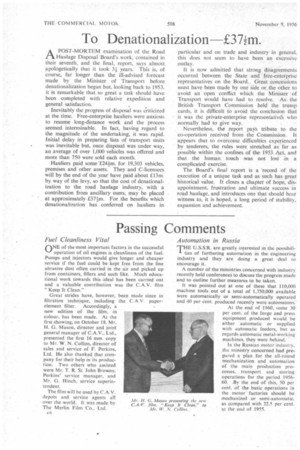To Denationalization frim.
Page 44

If you've noticed an error in this article please click here to report it so we can fix it.
A POST-MORTEM examination of the Road Haulage Disposal Board's work, contained in their seventh, and the final, report, says almost apologetically that it took 3i years. This is, of course, far longer than •the ill-advised forecast made by the Minister of Transport before denationalization began but, looking back to 1953, it is remarkable that so great a task should have been completed with relative expedition and general satisfaction. Inevitably the progress of disposal was Criticized at the time. Free-enterprise hauliers were anxious to resume long-distance work and the process seemed interminable. In fact, having regard to the magnitude of the undertaking, it was rapid. Initial delay in preparing lists of transport units was inevitable but, once disposal was under way, an average of over 1,000 vehicles was offered and more than 750 were sold each month.
Hauliers paid some T24fm. for 19,303 vehicles, premises and other assets. They and C-licensees will by the end of the year have paid about E13m. by way of the levy, so that the cost of denationalization to the road haulage industry, with a contribution from ancillary users, may be placed at approximately £371m. For the benefits which denationalization has conferred on hauliers in particular and on trade and industry in general, this does not seem to have been an excessive outlay.
It is now admitted that strong disagreements occurred between the State and free-enterprise representatives on the Board. Great concessions must have been made by one side or the other to avoid an open conflict which the Minister of Transport would have had to resolve. As the British Transport Commission held the trump cards, it is difficult to avoid the conclusion that it was the private-enterprise representative's who normally had to give way.
Nevertheless, thd report pays tribute to the co-operation received from the Commission. It appears that to overcome difficulties experienced by tenderers, the rules were stretched as far as possible within the confines of the 1953 Act, and that the human touch was not lost in a complicated exercise.
The Board's final report is a "record of the execution of a unique task and as such has great historical value. It closes a chapter of hope, disappointment, frustration and ultimate success in road haulage, and introduces one that should bear witness to, it is hoped, a long period of stability, expansion and achievement.




























































































































